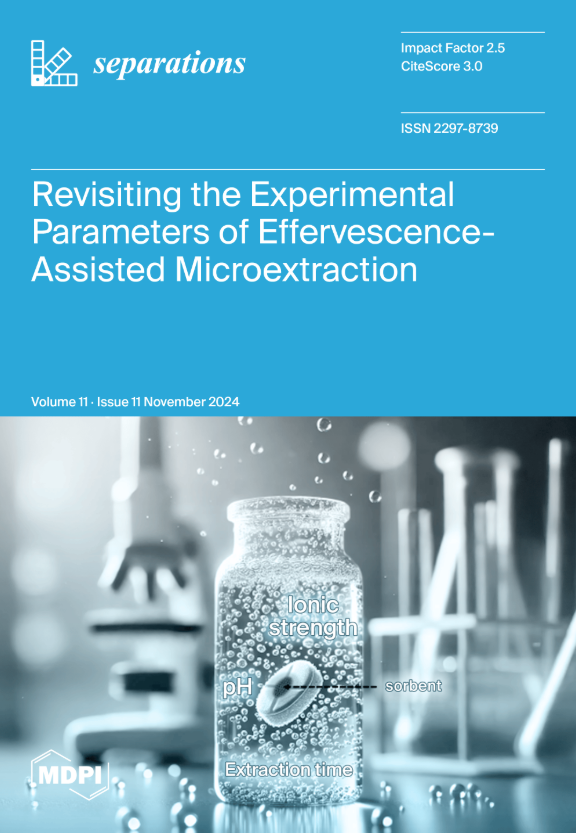非稳态挥发性有机化合物在活性炭上的扩散、分离和缓冲作用
IF 2.7
4区 工程技术
Q3 CHEMISTRY, ANALYTICAL
引用次数: 0
摘要
本研究探讨了非稳态排放的挥发性有机化合物在活性炭上的扩散、分离和缓冲作用。选择吸附容量和扩散速率差异较大的乙醇和二甲苯作为挥发性有机化合物的代表性目标污染物。本文选择具有一定吸入浓度和吸附平衡的活性炭作为研究对象。研究了脉冲负荷的缓冲效果。分析了缓冲效果和影响因素。结果表明,Bangham 方程能更有效地描述活性炭对乙醇和二甲苯的动态吸附过程,表明孔隙扩散是吸附过程中的速率决定步骤。R3 更适合作为评估非稳态排放的标准。脉冲时间和脉冲乘数等因素受到空床接触时间(EBCT)的影响,EBCT 与空床接触时间共同影响活性炭的缓冲性能。4 厘米的 EBCT 被确定为最佳床层高度,R3 达到 1.48。与极性挥发性有机化合物相比,具有化学对称结构的非极性挥发性有机化合物的传质速率更慢,因此活性炭的吸附容量更大,缓冲性能更好。本文章由计算机程序翻译,如有差异,请以英文原文为准。
Diffusion, Separation, and Buffering of Non-Steady-State VOCs Flow on Activated Carbon
In this study, the diffusion, separation, and buffering of volatile organic compounds emitted in a non-steady state on activated carbon were studied. Ethanol and xylene, which have large differences in adsorption capacity and diffusion rate, were selected as the representative target pollutants of volatile organic compounds. In this paper, activated carbon with a certain intake concentration and adsorption equilibrium was chosen as the research object. The buffering effect of pulse load was studied. The buffering effect and influencing factors were analyzed. The Bangham equation proved to be a more effective tool in describing the dynamic processes of ethanol and xylene adsorption on activated carbon, indicating that pore diffusion was the rate-determining step in the adsorption process. R3 emerged as a more suitable criterion for evaluating non-steady-state emissions. Factors such as pulse time and pulse multiplier were influenced by Empty Bed Contact Time (EBCT), which collaborated with EBCT to impact the buffering performance of activated carbon. An EBCT of 4 cm was identified as the optimal bed height, with R3 reaching 1.48. Non-polar VOCs with chemically symmetric structures exhibited slower mass transfer rates compared to polar VOCs, resulting in larger adsorption capacities on activated carbon and better buffering performance.
求助全文
通过发布文献求助,成功后即可免费获取论文全文。
去求助
来源期刊

Separations
Chemistry-Analytical Chemistry
CiteScore
3.00
自引率
15.40%
发文量
342
审稿时长
12 weeks
期刊介绍:
Separations (formerly Chromatography, ISSN 2227-9075, CODEN: CHROBV) provides an advanced forum for separation and purification science and technology in all areas of chemical, biological and physical science. It publishes reviews, regular research papers and communications. Our aim is to encourage scientists to publish their experimental and theoretical results in as much detail as possible. There is no restriction on the length of the papers. The full experimental details must be provided so that the results can be reproduced. There are, in addition, unique features of this journal:
Manuscripts regarding research proposals and research ideas will be particularly welcomed.
Electronic files and software regarding the full details of the calculation and experimental procedure, if unable to be published in a normal way, can be deposited as supplementary material.
Manuscripts concerning summaries and surveys on research cooperation and projects (that are funded by national governments) to give information for a broad field of users.
The scope of the journal includes but is not limited to:
Theory and methodology (theory of separation methods, sample preparation, instrumental and column developments, new separation methodologies, etc.)
Equipment and techniques, novel hyphenated analytical solutions (significantly extended by their combination with spectroscopic methods and in particular, mass spectrometry)
Novel analysis approaches and applications to solve analytical challenges which utilize chromatographic separations as a key step in the overall solution
Computational modelling of separations for the purpose of fundamental understanding and/or chromatographic optimization
 求助内容:
求助内容: 应助结果提醒方式:
应助结果提醒方式:


